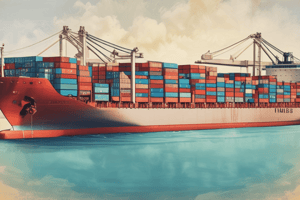Podcast
Questions and Answers
What determines the amount of countervailing duties (CVD) on foreign products?
What determines the amount of countervailing duties (CVD) on foreign products?
- The margin of dumping of the products
- The global market demand for the products
- The subsidy value of the foreign goods (correct)
- The production cost of the foreign goods
Which statement describes the primary function of the World Trade Organization (WTO)?
Which statement describes the primary function of the World Trade Organization (WTO)?
- To coordinate military efforts among member nations
- To mediate conflicts between governments
- To impose tariffs on all international trade
- To promote and regulate global trade among nations (correct)
When was the World Trade Organization (WTO) established?
When was the World Trade Organization (WTO) established?
- January 1, 1995 (correct)
- January 1, 1985
- January 1, 2010
- January 1, 2000
What is the maximum percentage of global trade represented by WTO member countries?
What is the maximum percentage of global trade represented by WTO member countries?
Where is the headquarters of the World Trade Organization located?
Where is the headquarters of the World Trade Organization located?
What is the primary purpose of imposing anti-dumping duties?
What is the primary purpose of imposing anti-dumping duties?
Which organization permits the use of anti-dumping measures?
Which organization permits the use of anti-dumping measures?
In the context of anti-dumping duties, what evidence must the government present?
In the context of anti-dumping duties, what evidence must the government present?
What is Countervailing Duty (CVD) primarily aimed at counteracting?
What is Countervailing Duty (CVD) primarily aimed at counteracting?
What is a potential downside of imposing anti-dumping duties for domestic consumers?
What is a potential downside of imposing anti-dumping duties for domestic consumers?
How does the government of India decide on the imposition of anti-dumping duties?
How does the government of India decide on the imposition of anti-dumping duties?
What could be considered dumping in trade practices?
What could be considered dumping in trade practices?
What distinguishes Anti-dumping duty from Countervailing duty?
What distinguishes Anti-dumping duty from Countervailing duty?
Flashcards are hidden until you start studying
Study Notes
Anti-Dumping Duty
- A protectionist tariff imposed by a domestic government on foreign imports believed to be priced below fair market value.
- Dumping occurs when a company exports products at significantly lower prices than in its home market.
- The duty is calculated based on the difference between normal costs in the importing country and the market value of similar goods in the exporting country.
- Aims to protect local businesses and markets from unfair competition by foreign imports.
- Designed to rectify trade distortion caused by dumping and re-establish fair trade conditions.
- The World Trade Organization (WTO) permits anti-dumping measures as fair competition instruments.
- Affected countries can take legal action against dumping if there is evidence of material injury to domestic industries.
- Governments must demonstrate the occurrence of dumping, quantify its extent, and prove injury or potential injury to the domestic market.
- While protective, anti-dumping duties may also result in higher prices for domestic consumers.
- In India, the Ministry of Finance makes the final decision on the imposition of anti-dumping duties.
Countervailing Duty (CVD)
- A specific import tax designed to protect domestic producers from the negative impacts of foreign subsidies.
- Imposed when foreign governments provide subsidies to producers, allowing products to be sold at lower prices in the importing country.
- CVD aims to prevent market flooding with subsidized goods and levels the playing field by nullifying price advantages.
- The WTO allows member countries to impose CVD as a trade protection measure.
CVD vs. Anti-Dumping Duty
- Anti-dumping duty focuses on preventing damage from low-priced foreign goods, while CVD targets goods benefiting from government subsidies.
- The amount of anti-dumping duty is based on the margin of dumping; CVD is determined by the subsidy value associated with the imported goods.
World Trade Organization (WTO)
- An international organization established on January 1, 1995, replacing GATT to promote and regulate global trade.
- Comprises 164 member countries, accounting for over 98% of global trade.
- Headquarters located in Geneva, Switzerland, and operates on a consensus-based decision-making process.
- Aims to facilitate free and fair trade by removing trade barriers and ensuring transparent resolution of trade disputes.
Studying That Suits You
Use AI to generate personalized quizzes and flashcards to suit your learning preferences.




